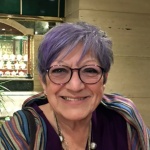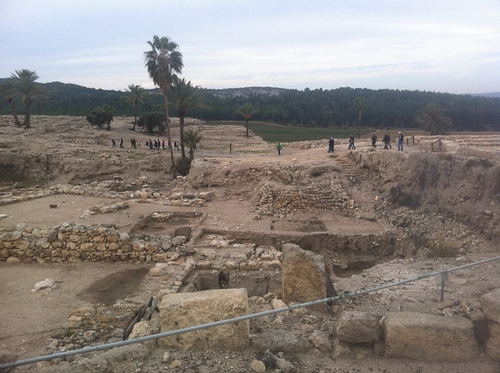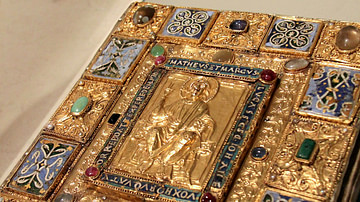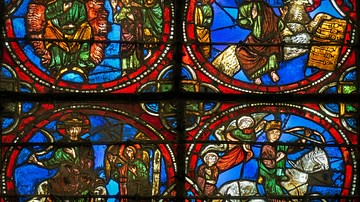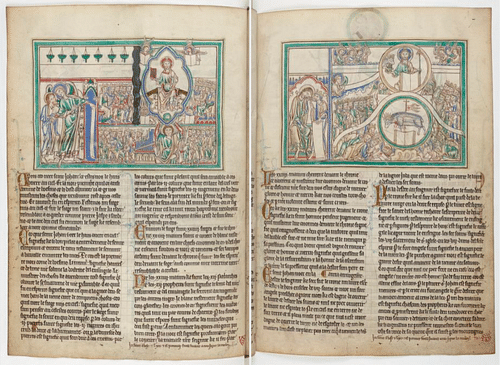
The book of Revelation or the Apocalypse of John of Patmos is one of the most famous books in the New Testament. Written near the end of the 1st century CE, it is the only apokalypsis (Greek: "unveiling of unseen realities") that was included in the New Testament canon and has been interpreted and reinterpreted for centuries, beginning in Late Antiquity, through the Middle Ages, and the modern world.
John of Patmos
An apocalypse was a text, not an event. By the 1st century CE, seers went into ecstatic trances in out-of-body journeys to heaven or had visions where they were shown what would happen when the God of Israel would institute his final intervention in human history and wrote them down.
Revelation is one of the few books in the Bible signed by its author. John opened the letter with the information that his name was John, in exile on the island of Patmos for being a Christian. This is the only clue we have regarding his social and economic status; he must have been upper-class or at least a citizen as common, lower-class criminals were executed in the arenas while Roman citizens had a more merciful punishment of enforced exile. He is not the same John who wrote the Gospel of John, the fourth gospel. Modern Christians make pilgrimages to the site of a Christian church built on the alleged cave on Patmos where John had his visions.
Historical Context
In 45 BCE, Julius Caesar had granted Jews exemption from the state cults of Rome as a reward for his Jewish mercenaries in his legions. At the end of the 1st century CE, the Roman emperor Domitian (r. 81-96 CE) mandated the imperial cult (the elevation of dead emperors who were now worshipped as divinities). In the formation of early Christianity, Christian communities, like Jews, ceased all traditional idolatry. But Christians were not ethnic Jews; they were not circumcised, and therefore Julius Caesar's exemption did not apply to them. Christians were convicted for the crime of atheism, disbelief and non-participation in the state cults of the Roman Empire. Construed as angering the gods, this imperilled everyone and was equivalent to treason and carried the death penalty. We have evidence of the first trials and executions at the beginning of the 2nd century in the works of Pliny the Younger on Christianity.
Rome's response to the spread of Christianity produced the first Christian martyrs, those who died for their beliefs and practices. John claimed that there were 144,000 martyrs in heaven (144,000 as a multiple of the twelve tribes of Israel). Martyrs were rewarded with being transported to heaven where they spent their time singing hymns and praises to God. The overall purpose of the book of Revelation was essentially to record John's visions and predictions of the return of Jesus Christ to earth, who would then take revenge upon Rome.
Scholars consider John of Patmos a Jewish Christian who utilized the prophetic books of Ezekiel and Daniel. In Revelation, Christ is the promised messiah of Davidic lineage. He is a conquering warrior-hero, who now fights against the enemies of the church. John included the predictions of the traditional prophets, that in the final days, violent tribulations would occur first. The tribulations consist of natural disasters (earthquakes, drought, famine, plague), aligned with the ten plagues of Egypt in Exodus. But human disasters ('sins') occur as well; wars, greed, corruption, and deviant sexual bahavior. For John, like the prophets, only the righteous will be saved. He presents the idea of predestination; salvation comes to those who were written in the Book of Life at the time of creation.

Where the letters of Paul and the gospels emphasize the repentance of sins that leads to forgiveness and thus salvation, Revelation contains no concept of repentance, especially repentance at the eleventh hour. As a typical apocalypse, the world is so corrupted by evil that it is too late. All humans are polarized as either righteous or sinners.
Seven Letters
The book opens with seven letters to Christian communities in Asia Province (modern Turkey) where imperial cult temples dominated the cities. Some of the communities were praised for their faithfulness in relation to persecution, while others were admonished for loss of faith. In one of the letters, John reviles those who belong to the "synagogue of Satan" (Revelation 2:9) Scholars debate what he meant by this. It could mean that some Christians were claiming to be Jews to avoid persecution. Or it could be a reference to what became a common Christian charge that Jews were ratting out Christians to the government, just as they did during the trial and crucifixion of Jesus of Nazareth, when they handed Jesus over to Pilate.
Symbolism
Apocalyptic literature was subversive, a way to criticize the current regime. Using codes, symbols, analogies, and other literary devices, only a select community could understand it. There are approximately 500 symbols and analogies in Revelation.
Then one of the seven angels who had the seven bowls came and said to me, "Come, I will show you the judgment of the great whore who is seated on many waters, with whom the kings of the earth have engaged in sexual immorality and with the wine of whose prostitution the inhabitants of the earth have become drunk. ... I saw a woman sitting on a scarlet beast that was full of blasphemous names, and it had seven heads and ten horns. The woman was clothed in purple and scarlet and adorned with gold and jewels and pearls, holding in her hand a golden cup full of abominations and the impurities of her prostitution, and on her forehead was written a name, a mystery: "Babylon the great, mother of whores and of earth's abominations. And I saw that the woman was drunk with the blood of the saints and the blood of the witnesses to Jesus."
(Revelation 17:1-6)
"Babylon the great" refers to the destruction of Solomon's Temple by the Babylonians in 586 BCE. The Second Temple was destroyed by the Roman Empire in 70 CE, and so the beast with "seven heads" refers to Rome and its seven hills. Throughout, Christians are warned not to mix with the dominant culture. They "are to get out of Babylon."
The reference to the "golden cup full of abominations" was incorporated into polemical condemnations of "sexual immorality" in the later Christian charge against pagans, i.e. those who had not yet converted. This included drunkenness, sexual orgies, and their continuing idolatry. Christians claimed that the traditional gods were Satan's agents, demons in disguise.
With symbols abundant, contemporary historical names and dates are rare. This has provided the book with an incredible elasticity that led to constant reinterpretation over time, usually in times of crisis. When the predictions are not manifest in a current age, it is not because the predictions were wrong. It is simply a matter of incorrect timing; God's final plan remains intact.
The Seven Seals & Seven Trumpets
Everything is in sevens, the perfect number with its reference to God's Sabbath of the seventh day. John has seven visions involving angels with seven seals and seven trumpets. The opening of the seals reveals the coming violence of the tribulations. When the first scroll is opened it unleashes four horses and riders, the four horsemen of the apocalypse. They represent, respectively, victory, war, food shortages (including monetary inflation), and death (the "sickly pale" rider, followed closely by Hades, the grave or Underworld).
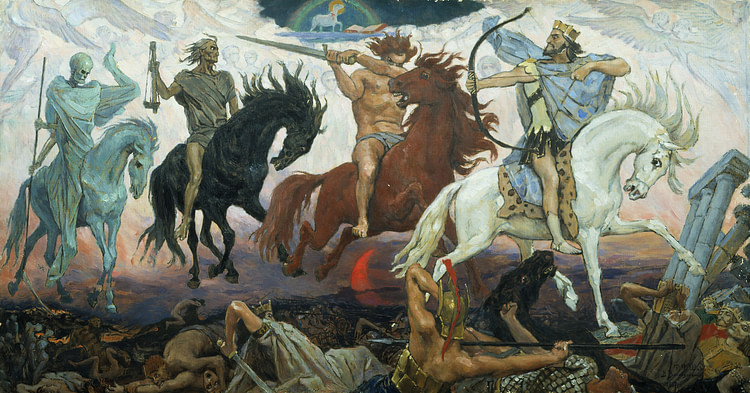
As most of the world suffers, angels will mark the foreheads of the believers to protect them. This is most likely drawn from Ezekiel 9:4: "Go through the city, through Jerusalem, and put a mark on the foreheads of those who sigh and groan over all the abominations that are committed in it."
Upon opening the seventh seal there is silence in heaven. John was told to eat this last scroll. It has both the taste of honey and bitterness, a twofold message of relief for believers, but punishment for all the rest. Eating the scroll keeps the timing hidden; only God knows when he will institute his final intervention.
The Final Battle
In chapter 12, we have the visions that describe the cosmic battle between the Lamb and the Dragon. Commonly misunderstood as the final battle site, John claims that Megiddo is the site where the armies of God (angels and Christians) gather, but then march south to Jerusalem. He calls the site har-Meggido ("mountain of Megiddo"), which is the origin of the common term 'armageddon' for the final events. Thousands of modern Christian pilgrims continue to visit the archaeological excavations at Megiddo in Israel.
In the Jewish Scriptures there are references borrowed from Mesopotamia, particularly in the idea of the primordial dragon. In their creation story, Enuma Elish, the god Marduk destroyed Tiamat, the dragon of chaos. Allusions to this primordial time and myth are found in the Scriptures. We have the dark, watery abyss and passages in which God defeats the chaotic monsters Rahab, Behemoth, or Leviathan (Ps. 74:13, 89:9–10; Job 26:1–14; Isa. 51:9).
Like in the fourth gospel, the author pictured Christ as "the lamb of God," a sacrificial victim. Ironically, however, the lamb turns out to be a powerful and destructive entity who ultimately will destroy the dragon. The dragon "has seven heads and ten horns ... that ancient serpent, who is called the devil and Satan" (Revelation 12:3, 12:9). The "ten horns" is a reference to the Roman emperors from Augustus to Domitian.
From apocalyptic sources, John claims that the dragon had already been tossed out of heaven by the archangel Michael. As Satan, the dragon remained chained in the abyss (hell). But the dragon sends his agent as a beast from the sea, and a second beast appears to enforce worship of the first beast (the Imperial cult). Like the Christians who are marked with a special sign, John said that the followers of the beast will be marked with a special sign, too. In the nature of apocalyptic writings, this is a riddle: the beast's number is that of a "man's name, and the numerical value of its letters is 666."
Numerology & the Anti-Christ
Hellenistic writing had a fascination with numbers, or numerology. The Greek philosopher Pythagoras speculated that the universe was structured on a harmony of numerical relationships and that certain combinations of numbers held a mystical significance. The ancients numbered things not by figures, but by letters of the alphabet (the Greek alpha for 1, beta for 2, Romans letters such as I, V, X, etc). The letters of a person's name carried a numerical value. In the Jewish tradition, seven represented the days of creation, culminating in God's Sabbath ("seventh-day") rest. Hence, seven stood for completion or perfection, making 666 a symbol for incomplete and imperfect.
John's hint that the beast's cryptic number could be identified with a specific person has inspired more speculation than almost any other statement in his book. In virtually every generation from John's day until ours, apocalyptists have found men or institutions that they claimed fit the beast's description and thus fulfilled the role of this beast as the anti-Christ, whose appearance confirms that the world is near its end.
In fact, "anti-Christ" does not appear in Revelation. It only appears in the first Johannine letter in the New Testament, as someone who was "against Christ." John described this figure as "the great deceiver." He will deceive the people into believing that he is controlling the world for their good. Most New Testament scholars believe that John referred to a historical person of his own time. Who that person might have been, however, is debated. Some historians believe the man who best fits John's description of the beast is Nero (r. 54-68 CE), where tradition claims that he was the first emperor to persecute Christians. John's claim of a "beast who arises from the sea" may refer to popular rumors at the time. Following Nero's suicide in 68, several imposters claimed to be Nero and planned to gather an army to reassert his rule. Another theory is that John referred to both evil emperors; the dead tyrant Nero was 'reborn' in Domitian. John's point was the element of deceit. We should always look for someone who appears good and a benefactor but be alerted to recognize his evil in the disguise of good.
Visions of the Final Triumph
In chapter 20, when Christ returns to earth, he begins to institute the kingdom of God. During this time, the dead martyrs are resurrected, they join with the living faithful and help wage war against the beast. This lasts for 1000 years, a millennium. The dragon is finally released from his chains in the abyss to join in the final battle with the lamb. Fire from heaven destroys the enemies, including the dragon.
After the final battle, the resurrection of all the dead then takes place when they are judged. For the wicked, this includes the image of being tossed in the "lake of fire," a reference to the Dead Sea, which contained minerals that burned the skin. John's reward for the faithful is found in a metaphor of a wedding of the lamb and the city of Jerusalem. We will then have the idyllic utopia, the original plan of God for the Garden of Eden, not in heaven, but on earth. A new and restored Temple (with crystal streams of gold, and precious gems) descends upon Jerusalem.
In describing the dragon, John utilized Isaiah's oracle against the king of Babylon. Kings in Babylon were associated with divinity. Isaiah castigated the king of Babylon for his hubris, for trying to attain the status of equality with the gods. Isiah prophesized that eventually the king would "be cast down" to the abyss. In addressing the king of Babylon, Isaiah used one of his throne names, "the day-star of his people."
The 5th-century church father, Jerome, translated the Hebrew of the Jewish Scriptures and the Greek of the New Testament into one volume in Latin (the Vulgate Bible of the Middle Ages). When he got to this section of Revelation, he knew that the Romans worshipped a "day-star" whose name was Lucifer. He simply translated it as Lucifer, the most popular name for the Devil in the Middle Ages.
As time passed, the "thousand years" was interpreted in the Middle Ages to be connected to the earth's clock. As the year 1000 approached, peasants neglected to plant their crops, with the belief that the impending catastrophe/glory was about to emerge. Subsequent crises, such as the Bubonic plague of the 14th century, were interpreted as "signs of the end."
The Rapture
Another concept that many people believe comes from the book of Revelation is not in the book. The concept of the 'rapture' was created by a 17th-century British minister who worried about the 'times of tribulation'. He turned to the letters of Paul the Apostle to the Gentiles. In the first letter to the Thessalonians, Paul described what would happen when Christ returned, in that those who are left alive at the time would be transported to the heavens to welcome Christ. Righteous Christians would be miraculously raptured up heaven to save them from the impending doom.
Legacy in Western History & Culture
The book of Revelation was debated by Christians leaders and was not included in the official canon until 400 years later. The debates concerned the alleged author and some of his mystical descriptions of heaven. It was finally canonized because of its teachings on the dire fate of sinners.
The book of Revelation unfortunately has been called upon to validate the history of violence by Christianity for 2000 years: The Crusades, the Inquisition against heretics, the religious wars of Europe, the near annihilation of Native cultures in the Americas, the institution of slavery for African Americans, and continuing polemic against Jews and Muslims. The rationale is found in the conviction that God will punish all of us because we continue to let evil exist. The abuse of this book (and the danger that it still carries) is that a sinner is anyone who disagrees with one's own interpretation of Christianity.
What remains problematic is who gets to decide who is a sinner. Revelation continues to be applied in modern debates concerning same-sex relationships, gender roles, gender identification, and abortion. Believers still turn to Revelation in times of crisis: wars, climate disasters, the fluctuating stock market and inflation, aligned with the four horsemen. Hollywood contributes to the popularity of Revelation in the dozens of science fiction films featuring dystopian, post-apocalyptic societies by incorporating elements of this book.
In relation to Christian theology, the text remains a source of inspiration for believers in the symmetry of its placement at the end of the New Testament. Beginning with creation in Genesis, God's plan for humans culminates in the hope that Christ will eventually institute his kingdom on earth, upending contemporary evils and restoring justice in the universe.
